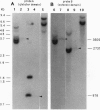Abstract
We report here the identification of a pollen-specific gene from Zea mays that contains multiple Ser-(Pro)n repeats, the motif found in the cell wall-associated extensins. Sequence analysis reveals that the encoded protein has a putative globular domain at the N terminus and an extensin-like domain at the C terminus. The Pex1 (pollen extensin-like) gene is expressed exclusively in pollen, not in vegetative or female tissues, and is not induced in leaves upon wounding. We propose that the encoded protein may have a role in reproduction, either as a structural element deposited in the pollen tube wall during its rapid growth or as a sexual recognition molecule that interacts with partner molecules in the pistil.
Full text
PDF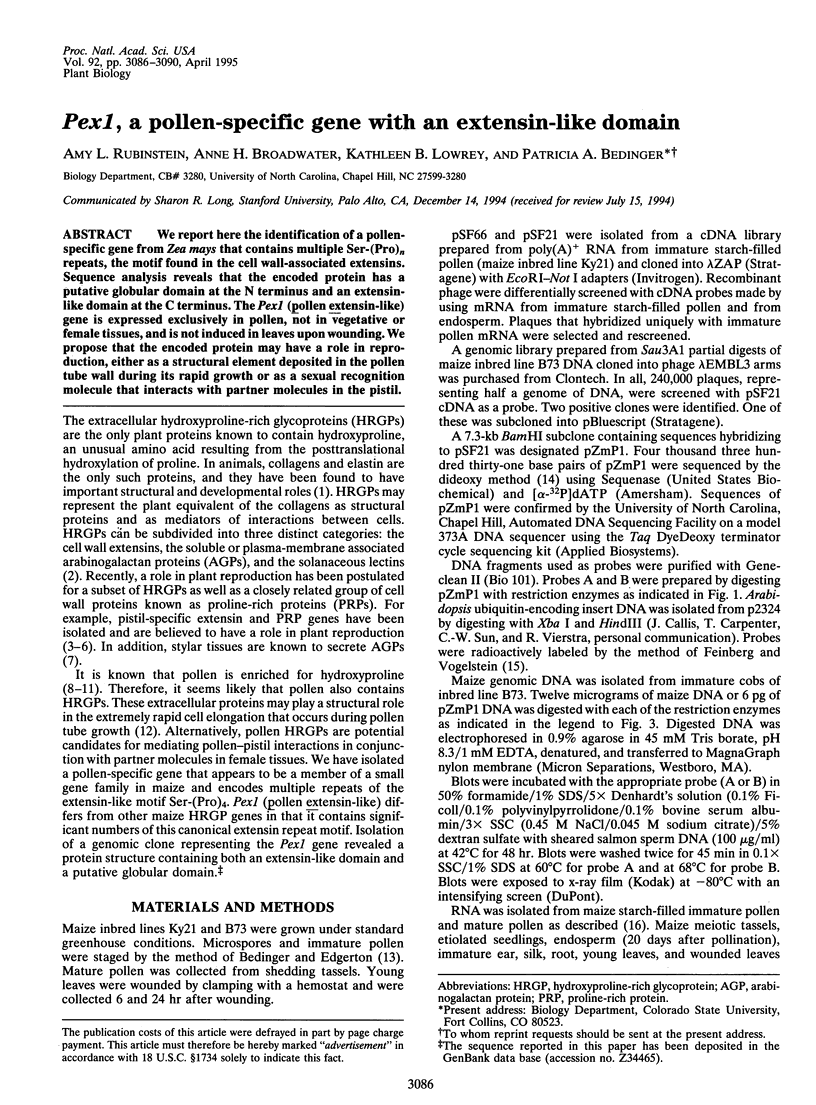
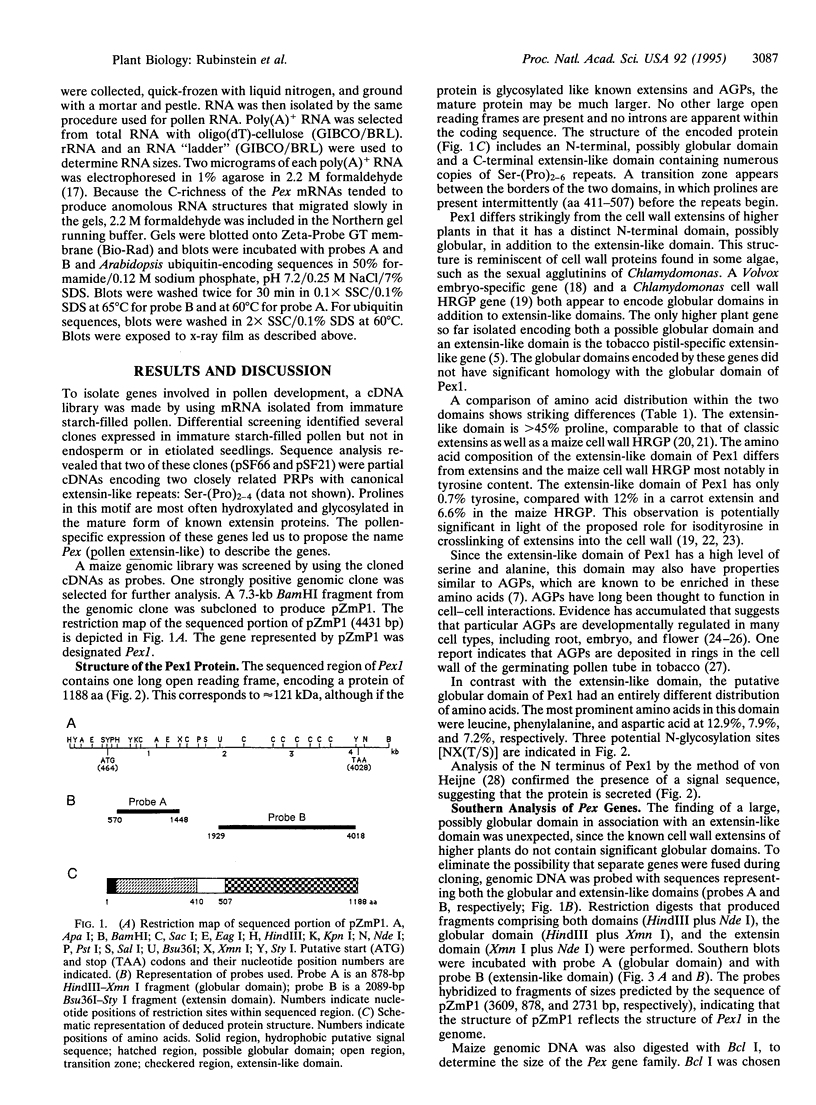
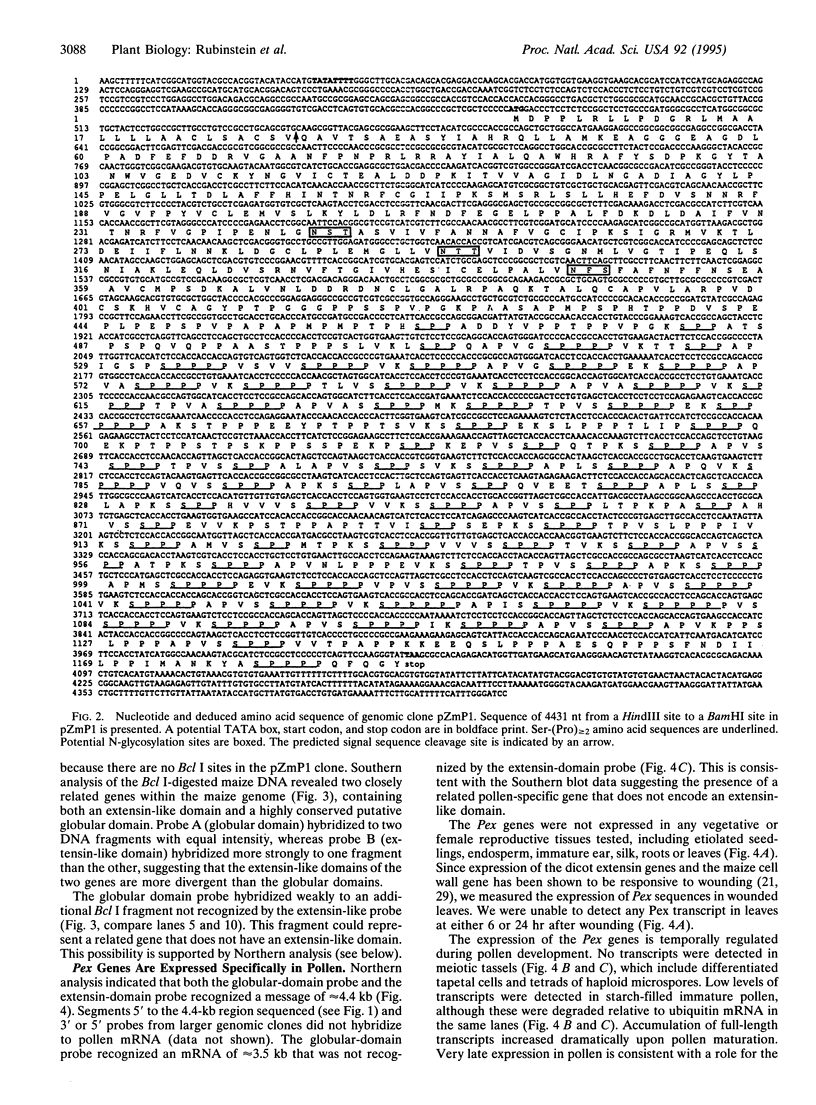
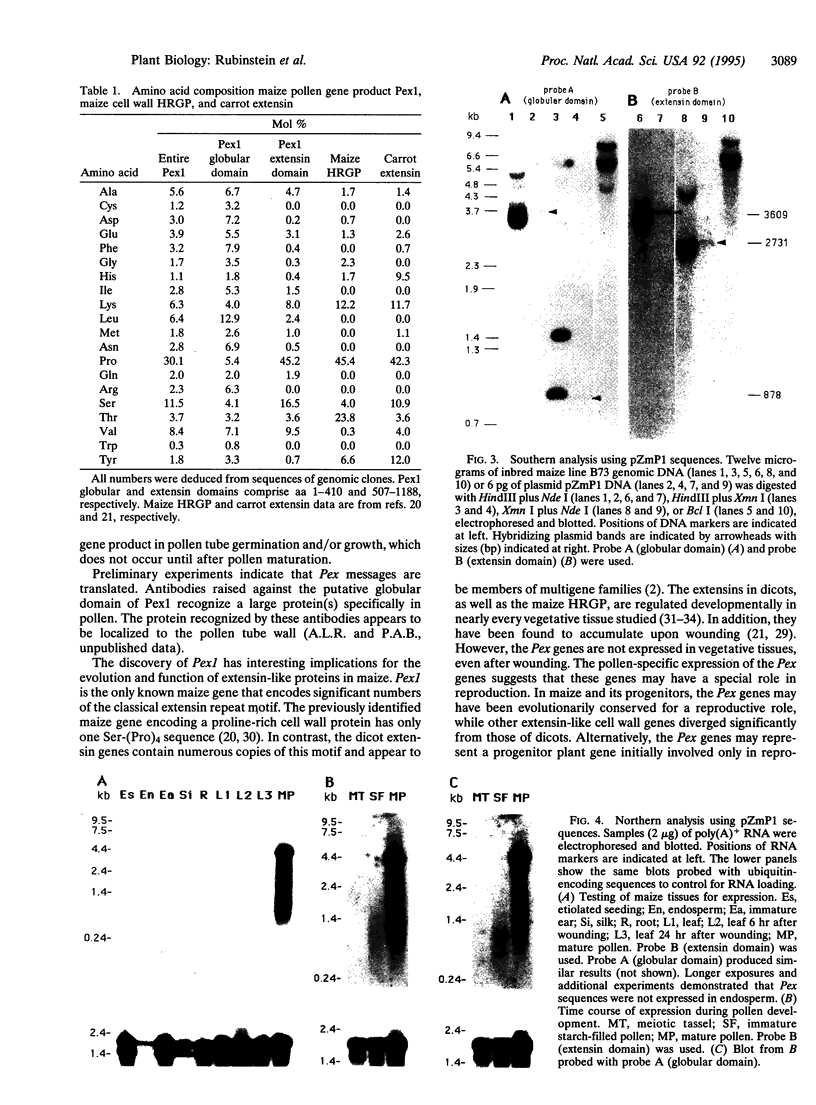
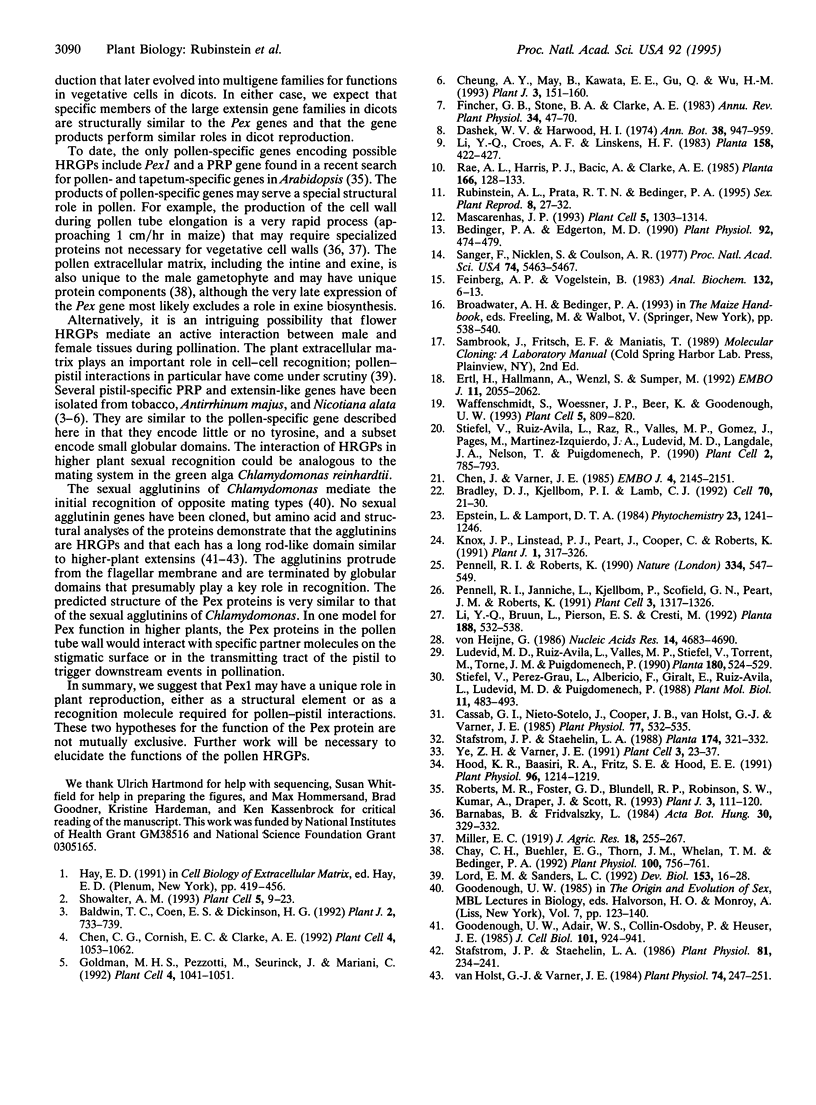
Images in this article
Selected References
These references are in PubMed. This may not be the complete list of references from this article.
- Baldwin T. C., Coen E. S., Dickinson H. G. The ptl1 gene expressed in the transmitting tissue of Antirrhinum encodes an extensin-like protein. Plant J. 1992 Sep;2(5):733–739. doi: 10.1046/j.1365-313x.1992.t01-14-00999.x. [DOI] [PubMed] [Google Scholar]
- Bedinger P. A., Edgerton M. D. Developmental staging of maize microspores reveals a transition in developing microspore proteins. Plant Physiol. 1990 Feb;92(2):474–479. doi: 10.1104/pp.92.2.474. [DOI] [PMC free article] [PubMed] [Google Scholar]
- Bradley D. J., Kjellbom P., Lamb C. J. Elicitor- and wound-induced oxidative cross-linking of a proline-rich plant cell wall protein: a novel, rapid defense response. Cell. 1992 Jul 10;70(1):21–30. doi: 10.1016/0092-8674(92)90530-p. [DOI] [PubMed] [Google Scholar]
- Cassab G. I., Nieto-Sotelo J., Cooper J. B., van Holst G. J., Varner J. E. A developmentally regulated hydroxyproline-rich glycoprotein from the cell walls of soybean seed coats. Plant Physiol. 1985 Mar;77(3):532–535. doi: 10.1104/pp.77.3.532. [DOI] [PMC free article] [PubMed] [Google Scholar]
- Chay C. H., Buehler E. G., Thorn J. M., Whelan T. M., Bedinger P. A. Purification of maize pollen exines and analysis of associated proteins. Plant Physiol. 1992 Oct;100(2):756–761. doi: 10.1104/pp.100.2.756. [DOI] [PMC free article] [PubMed] [Google Scholar]
- Chen C. G., Cornish E. C., Clarke A. E. Specific expression of an extensin-like gene in the style of Nicotiana alata. Plant Cell. 1992 Sep;4(9):1053–1062. doi: 10.1105/tpc.4.9.1053. [DOI] [PMC free article] [PubMed] [Google Scholar]
- Chen J., Varner J. E. An extracellular matrix protein in plants: characterization of a genomic clone for carrot extensin. EMBO J. 1985 Sep;4(9):2145–2151. doi: 10.1002/j.1460-2075.1985.tb03908.x. [DOI] [PMC free article] [PubMed] [Google Scholar]
- Cheung A. Y., May B., Kawata E. E., Gu Q., Wu H. M. Characterization of cDNAs for stylar transmitting tissue-specific proline-rich proteins in tobacco. Plant J. 1993 Jan;3(1):151–160. [PubMed] [Google Scholar]
- Crétin C., Puigdomènech P. Glycine-rich RNA-binding proteins from Sorghum vulgare. Plant Mol Biol. 1990 Nov;15(5):783–785. doi: 10.1007/BF00016128. [DOI] [PubMed] [Google Scholar]
- Ertl H., Hallmann A., Wenzl S., Sumper M. A novel extensin that may organize extracellular matrix biogenesis in Volvox carteri. EMBO J. 1992 Jun;11(6):2055–2062. doi: 10.1002/j.1460-2075.1992.tb05263.x. [DOI] [PMC free article] [PubMed] [Google Scholar]
- Feinberg A. P., Vogelstein B. A technique for radiolabeling DNA restriction endonuclease fragments to high specific activity. Anal Biochem. 1983 Jul 1;132(1):6–13. doi: 10.1016/0003-2697(83)90418-9. [DOI] [PubMed] [Google Scholar]
- Goldman M. H., Pezzotti M., Seurinck J., Mariani C. Developmental expression of tobacco pistil-specific genes encoding novel extensin-like proteins. Plant Cell. 1992 Sep;4(9):1041–1051. doi: 10.1105/tpc.4.9.1041. [DOI] [PMC free article] [PubMed] [Google Scholar]
- Goodenough U. W., Adair W. S., Collin-Osdoby P., Heuser J. E. Structure of the Chlamydomonas agglutinin and related flagellar surface proteins in vitro and in situ. J Cell Biol. 1985 Sep;101(3):924–941. doi: 10.1083/jcb.101.3.924. [DOI] [PMC free article] [PubMed] [Google Scholar]
- Hood K. R., Baasiri R. A., Fritz S. E., Hood E. E. Biochemical and tissue print analyses of hydroxyproline-rich glycoproteins in cell walls of sporophytic maize tissues. Plant Physiol. 1991 Aug;96(4):1214–1219. doi: 10.1104/pp.96.4.1214. [DOI] [PMC free article] [PubMed] [Google Scholar]
- Lord E. M., Sanders L. C. Roles for the extracellular matrix in plant development and pollination: a special case of cell movement in plants. Dev Biol. 1992 Sep;153(1):16–28. doi: 10.1016/0012-1606(92)90088-x. [DOI] [PubMed] [Google Scholar]
- Mascarenhas J. P. Molecular Mechanisms of Pollen Tube Growth and Differentiation. Plant Cell. 1993 Oct;5(10):1303–1314. doi: 10.1105/tpc.5.10.1303. [DOI] [PMC free article] [PubMed] [Google Scholar]
- Pennell R. I., Janniche L., Kjellbom P., Scofield G. N., Peart J. M., Roberts K. Developmental Regulation of a Plasma Membrane Arabinogalactan Protein Epitope in Oilseed Rape Flowers. Plant Cell. 1991 Dec;3(12):1317–1326. doi: 10.1105/tpc.3.12.1317. [DOI] [PMC free article] [PubMed] [Google Scholar]
- Roberts M. R., Foster G. D., Blundell R. P., Robinson S. W., Kumar A., Draper J., Scott R. Gametophytic and sporophytic expression of an anther-specific Arabidopsis thaliana gene. Plant J. 1993 Jan;3(1):111–120. [PubMed] [Google Scholar]
- Roberts P. L., Martin F. M., Schoetz D. J., Jr, Murray J. J., Coller J. A., Veidenheimer M. C. Bleeding stomal varices. The role of local treatment. Dis Colon Rectum. 1990 Jul;33(7):547–549. doi: 10.1007/BF02052204. [DOI] [PubMed] [Google Scholar]
- Sanger F., Nicklen S., Coulson A. R. DNA sequencing with chain-terminating inhibitors. Proc Natl Acad Sci U S A. 1977 Dec;74(12):5463–5467. doi: 10.1073/pnas.74.12.5463. [DOI] [PMC free article] [PubMed] [Google Scholar]
- Showalter A. M. Structure and function of plant cell wall proteins. Plant Cell. 1993 Jan;5(1):9–23. doi: 10.1105/tpc.5.1.9. [DOI] [PMC free article] [PubMed] [Google Scholar]
- Stafstrom J. P., Staehelin L. A. Cross-linking patterns in salt-extractable extensin from carrot cell walls. Plant Physiol. 1986 May;81(1):234–241. doi: 10.1104/pp.81.1.234. [DOI] [PMC free article] [PubMed] [Google Scholar]
- Stiefel V., Ruiz-Avila L., Raz R., Pilar Vallés M., Gómez J., Pagés M., Martínez-Izquierdo J. A., Ludevid M. D., Langdale J. A., Nelson T. Expression of a maize cell wall hydroxyproline-rich glycoprotein gene in early leaf and root vascular differentiation. Plant Cell. 1990 Aug;2(8):785–793. doi: 10.1105/tpc.2.8.785. [DOI] [PMC free article] [PubMed] [Google Scholar]
- Waffenschmidt S., Woessner J. P., Beer K., Goodenough U. W. Isodityrosine cross-linking mediates insolubilization of cell walls in Chlamydomonas. Plant Cell. 1993 Jul;5(7):809–820. doi: 10.1105/tpc.5.7.809. [DOI] [PMC free article] [PubMed] [Google Scholar]
- Ye Z. H., Varner J. E. Tissue-Specific Expression of Cell Wall Proteins in Developing Soybean Tissues. Plant Cell. 1991 Jan;3(1):23–37. doi: 10.1105/tpc.3.1.23. [DOI] [PMC free article] [PubMed] [Google Scholar]
- van Holst G. J., Varner J. E. Reinforced Polyproline II Conformation in a Hydroxyproline-Rich Cell Wall Glycoprotein from Carrot Root. Plant Physiol. 1984 Feb;74(2):247–251. doi: 10.1104/pp.74.2.247. [DOI] [PMC free article] [PubMed] [Google Scholar]
- von Heijne G. A new method for predicting signal sequence cleavage sites. Nucleic Acids Res. 1986 Jun 11;14(11):4683–4690. doi: 10.1093/nar/14.11.4683. [DOI] [PMC free article] [PubMed] [Google Scholar]



